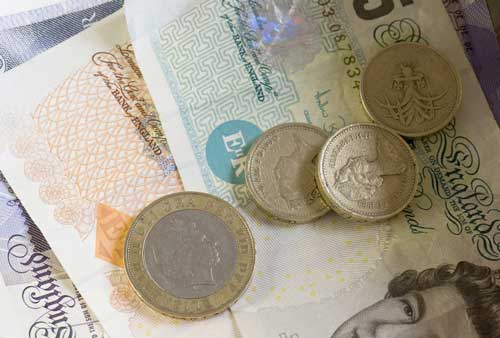Since the 2021/2022 tax year, the UK government has implemented one of the most significant stealth tax increases in recent history by freezing tax-free allowances and tax thresholds. Originally announced to last until 2028, this freeze was extended in the 2025 Budget to continue until the 2031/2032 tax year; resulting in a full decade of frozen allowances and thresholds.
Our main tax calculator now helps you understand exactly how much this policy will cost you. Whether you're an employee or self-employed this additional tool shows the real impact of frozen thresholds on your take-home pay, by calculating both income tax and National Insurance contributions, whilst accounting for inflation.
What Are Frozen Tax Thresholds?
Tax thresholds are the income levels at which different tax rates apply. The main thresholds that have been frozen since 2021/2022 include:
- Personal Allowance: £12,570 (the amount you can earn tax-free)
- Basic Rate Threshold: £50,270 (income up to this level is taxed at 20% - aka Basic Rate)
- Higher Rate Threshold: £50,270 to £125,140 (taxed at 40% - aka Higher Rate)
- Additional Rate Threshold: Over £125,140 (taxed at 45% - aka Additional or Top Rate)
Notably, the additional rate threshold actually decreased from £150,000 to £125,140 in 2023/24, making the situation even worse for top earners. As we explored in our analysis of how higher-rate taxpayers have increased five-fold over 30 years, this trend of more people being pulled into higher tax brackets has been accelerating.
The National Insurance Connection
What many people don't realise is that National Insurance thresholds were also effectively frozen. In 2022/2023, the government aligned the NIC primary threshold with the personal allowance at £12,570. This alignment meant that NIC thresholds became frozen too, creating a double impact on workers' take-home pay.
While NIC rates have fluctuated over this period (including the temporary Health and Social Care Levy in 2022/23 and subsequent rate reductions), the frozen thresholds mean more of your income is subject to NIC as wages rise with inflation.
Understanding Fiscal Drag: The Stealth Tax
Fiscal drag is the mechanism by which frozen tax thresholds create a stealth tax increase. Here's how it works:
Imagine you earn £35,000 in 2025/26. With typical wage growth matching inflation at around 2% per year, your salary might rise to approximately £39,500 by 2031/32. In a normal scenario, tax thresholds would also increase with inflation, meaning the proportion of your income that's taxed would remain roughly constant.
However, with frozen thresholds, while your income grows, the tax-free allowance and rate bands stay the same. This means:
- A larger proportion of your income becomes taxable
- More of your income may be pushed into higher tax brackets
- You pay more tax without any change in tax rates
- Your real-terms (inflation-adjusted) take-home pay decreases
This phenomenon is particularly severe for those earning near threshold boundaries. Someone earning £48,000 today might find themselves pushed into the 40% higher rate tax bracket as their salary increases with inflation, while the £50,270 threshold remains frozen. As we detailed in our article on the effects of freezing tax thresholds, this creates a significant additional tax burden beyond the baseline freeze impact.
How to Use the Frozen Thresholds Calculator
Our calculator is designed to be intuitive while providing comprehensive insights into your personal tax situation. Here's how to get the most from it:
Step 1: Enter Your Income Details in our main tax calculator as usual
Start by entering your gross annual income in the main income tax calculator section. Make sure to select the correct tax year—this is important because the calculator uses this as your baseline year. For example, if you select 2025/2026 and enter £30,000, the calculator treats this as your income in 2025/26 terms.
Step 2: Navigate to the Frozen Thresholds Section
Once you've run your main tax calculation, scroll down to find the "Impact of the Tax Allowances and Thresholds Freeze" section. This is where the magic happens.
Step 3: Choose Your Income Scenario
The calculator offers two scenarios via a checkbox toggle:
Inflation-Adjusted Income (Default): This assumes your income will increase with inflation each year. This is the more realistic scenario for most people, as wages typically rise with inflation over time. This option shows you the full fiscal drag effect (both the impact of frozen thresholds and the additional burden of being pushed into higher tax brackets).
Constant Income: This keeps your income fixed at the amount you entered. Use this option if you want to see the pure impact of frozen thresholds without considering wage growth, or if you're on a fixed income that won't increase.
Step 4: Interpret the Results
The calculator presents your results in three ways:
A Summary: At the top, you'll see a bold statement showing your total extra deductions by 2031/32. This is the cumulative amount you'll pay extra over the entire freeze period compared to if thresholds had increased with inflation.
An Interactive Chart: The chart visualises your tax and NIC journey over the freeze period. You'll see four key lines:
- Your income (either constant or inflation-adjusted)
- Total deductions with frozen thresholds (reality)
- Total deductions with inflation-adjusted thresholds (what it should be)
- The annual difference between the two
Hover over any point on the chart to see exact figures for that tax year.
A Detailed Table: Scroll down to see a year-by-year breakdown showing your income, income tax, National Insurance, and total deductions for both scenarios. The table is scrollable, making it easy to compare specific years. The "Cumulative Extra" column shows how the burden builds up over time.
Real-World Examples
Example 1: Basic Rate Taxpayer (£30,000)
Sarah earns £30,000 per year in 2025/26. Let's see how the freeze affects her:
With constant income: Sarah pays approximately £5,400 extra in total deductions by 2031/32. This is purely due to the frozen thresholds—as inflation erodes the real value of the personal allowance, a larger proportion of her £30,000 becomes taxable.
With inflation-adjusted income: If Sarah's salary keeps pace with inflation, growing to around £33,800 by 2031/32, she still pays approximately £5,400 extra. Why the same? Because she remains comfortably within the basic rate band throughout the period. The proportion of her income that's taxable stays roughly constant—the freeze affects her, but she doesn't experience additional fiscal drag from crossing into higher brackets.
Example 2: Near Higher Rate Threshold (£48,000)
James earns £48,000 per year in 2025/26. His situation is more complex:
With constant income: James pays approximately £5,400 extra by 2031/32. He stays just below the £50,270 higher rate threshold throughout, so he experiences the baseline freeze impact.
With inflation-adjusted income: James pays approximately £7,500 extra by 2031/32; that's £2,100 more than the constant income scenario! Why? Because his inflation-adjusted salary grows to around £55,000 by 2031/32, pushing him over the frozen £50,270 threshold. Around £5,000 of his income gets taxed at 40% instead of 20%. If thresholds had risen with inflation, that threshold would be around £57,000, and he'd still be in the basic rate band. This is fiscal drag in action.
Why This Matters More Than You Think
The frozen thresholds policy represents one of the largest tax increases in modern UK history, yet it's largely invisible to most taxpayers. Unlike an announced increase in tax rates, which would be politically controversial, freezing thresholds allows the government to increase tax revenue through inflation; a process that happens automatically without requiring new legislation.
By 2028/29, the Institute for Fiscal Studies estimated that the freeze would pull an additional 2.6 million people into paying income tax and 2.1 million into the higher rate band. With the extension to 2031/32, these numbers will be even higher. Our analysis of whether the next government might unfreeze tax thresholds explored the political and fiscal challenges of reversing this policy.
For individuals, the cumulative impact is substantial. A typical worker might pay £5,000 - £8,000 extra over the freeze period; money that could have gone toward savings, investments, or everyday expenses. For those pushed into higher tax brackets, the impact is even more severe.
The Broader Context
The frozen thresholds policy doesn't exist in isolation. It's part of a broader fiscal strategy that includes other measures affecting taxpayers. For instance, the recent 2p tax rise on property, savings, and dividends announced in Budget 2025 compounds the pressure on household finances.
Understanding your complete tax picture is crucial for financial planning. While you can't avoid the frozen thresholds, you can:
- Maximise pension contributions to reduce taxable income
- Use ISA allowances to shelter investment income
- Consider salary sacrifice schemes for benefits like childcare vouchers
- Plan for the tax implications of pay rises and bonuses
- Review your tax code to ensure you're not overpaying
Technical Notes and Assumptions
For transparency, here are the key assumptions and data sources used in our calculator:
- Inflation rates: We use actual CPI figures for 2021/22 through 2024/25, and OBR projected rates of 2% per annum for future years (2025/26 onwards).
- NIC rates: The calculator uses the actual NIC rates for each year, including the temporary Health and Social Care Levy period (2022/23) and subsequent rate reductions.
- Additional rate threshold: We account for the reduction from £150,000 to £125,140 that occurred in 2023/24.
- Class 2 NIC: For self-employed workers, we include Class 2 NIC for years where it applied (abolished from 2023/24 for most workers).
- Comparison methodology: The "adjusted" scenario uses the same tax and NIC rates as the frozen scenario but applies inflation-adjusted thresholds. This isolates the impact of the threshold freeze itself.
The calculator provides a simplified model and doesn't account for:
- Personal allowance tapering for incomes over £100,000
- Scottish tax rates and bands (which differ from the rest of the UK)
- Marriage allowance transfers
- Student loan repayments
- Pension contributions and tax relief
- Other allowances and deductions
For a complete picture of your tax situation including these factors, use our comprehensive effect of frozen tax thresholds calculator.
Looking Ahead
With the freeze now confirmed to last until 2031/32, it's more important than ever to understand its impact on your finances. Whether you're planning your career, negotiating a salary, or making investment decisions, knowing how much of your income growth will be eroded by frozen thresholds is crucial information.
The political landscape may change, and future governments might choose to unfreeze thresholds earlier than 2031/32. However, given the significant revenue this policy generates for the Treasury (estimated at over £40 billion per year by the end of the freeze period) any reversal would require difficult decisions about spending cuts or alternative tax increases.
Use our calculator regularly as your circumstances change. Whether you receive a pay rise, change jobs, or move between employment types, understanding the true cost of frozen thresholds will help you make informed financial decisions.



